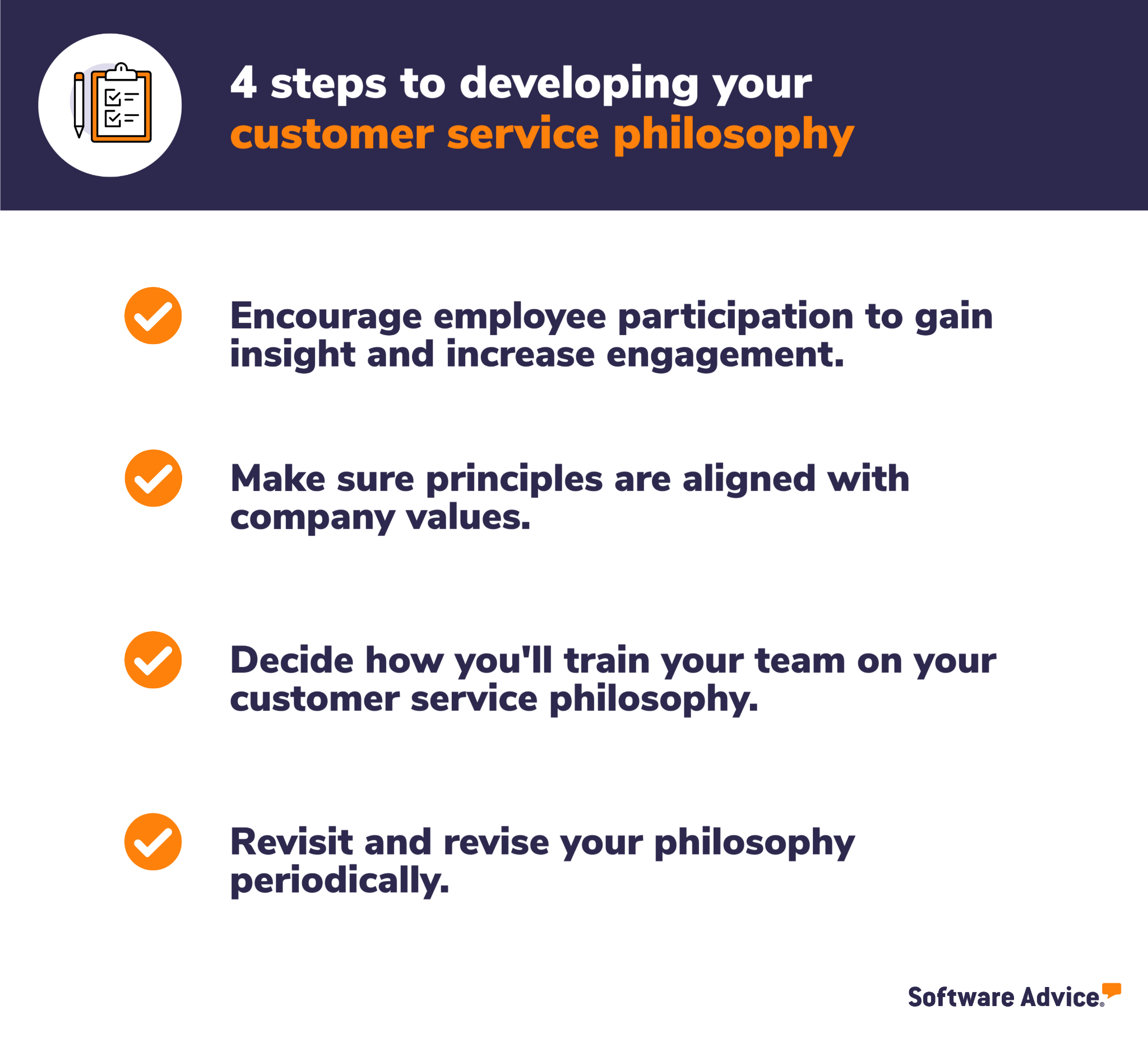Increase Customer Retention With a Strong Customer Service Philosophy
A customer service philosophy is a short statement that provides a framework for customer interactions. It can be as brief as a phrase or sentence, or it can be as long as a paragraph. Similar to a mission statement, it’s meant to guide any decisions made by your customer support team. A strong customer service philosophy:
Articulates company values.
Ensures that a customer’s interactions are consistent, no matter which customer service agent they interact with.
Translates to company policy.
Whether it’s featured on your website or within training materials, it’s important to establish your philosophy in writing for easy reference. And it’s equally important to invest time and consideration into your philosophy to ensure it’s aligned with your company values and that it’s something your team can execute. We’ll help you get there through the four steps below.
4 steps to developing a strong customer service philosophy
Here are four steps to developing a great customer service philosophy that encapsulates your company values, ensures consistent interactions, and translates to company policy.
Step #1: Encourage employee participation to gain insight and increase engagement
The task of drafting any official company statement usually falls to the leadership team, but inviting other employees to weigh in on your customer service philosophy can have a positive impact on your workplace. First, it guarantees that employees who most regularly interact with the public have a chance to share their experience.
Second, it shows that you value your employees’ input. As a small-business owner, it’s in your best interest to develop a philosophy that considers your team as well as customers. A recent Gallup poll found that disengaged teams face 18% to 43% higher turnover rates than engaged teams. What’s more, replacing workers can cost half to two times an employee’s salary.

Opportunities to involve everyone in the writing process might look like:
Asking for input via surveys
Inviting feedback during 1:1 meetings
Reflecting on customer interactions during employee review
Holding brainstorming sessions during group meetings
What does it look like to consider employee experience in your customer service philosophy?
Perhaps one of your agents, Jack, accommodated a customer, Jill, despite Jill being past her warranty. As a result, Jill continues to choose your business over competitors. In this example, prioritizing customers over policy could be one of your philosophy’s guiding principles because it has proven to increase customer retention.
On the other hand, sometimes employee experience can help you decide what not to include in your philosophy. “The customer is always right” is a common guiding principle, but it’s one that can lower employee morale, and cause employees to spend too much time trying to appease one customer. If any part of your customer service philosophy makes your employees’ jobs harder or more stressful, nix it.
Once you and your team agree on some guiding principles that keep everyone’s best interests in mind, you’ll want to ensure that they’re aligned with your company values.
Step #2: Make sure principles are aligned with company values
This next step involves revisiting your company values–or, if you’re not sure what those are, naming them to achieve a more narrowed focus in your customer service philosophy.
Company values may not be something you’ve ever written down, and that’s okay. They’re the beliefs that drive your business—what your company prides itself on. The chart below describes some common company values and how they might appear in a customer service philosophy.
What does it look like to integrate your company values in your customer service philosophy?
If your value is this: | Your customer service philosophy might include something along these lines: |
A family-friendly environment | “We pledge to maintain an atmosphere that’s welcoming to guests of all ages with a variety of food and entertainment options.” |
Affordability | “Our technicians will go over the cost of each service beforehand so that you can shop according to your needs.” |
Integrity | “If we wouldn’t feed it to our families, we won’t sell it to yours.” |
Expertise | “Our employees undergo a rigorous training program that ensures they possess the skills they need to assist you.” |
The purpose of ensuring the guiding principles of your customer service philosophy are aligned with your company values is to put theory into practice: here’s what we believe, and here’s how we’re going to communicate that through our customer service.
Gaining clarity on what these principles look like in practice will also help you give your team clear instructions on how to uphold your company values. More on that in our next step, which covers implementing your customer service philosophy into training.
Step #3: Decide how you’ll train your team on your customer service philosophy
A customer service philosophy can talk a big game, but the true test comes down to how it’s enacted by your customer service team. Make sure your company is walking the walk as well as talking the talk by implementing your customer service philosophy into employee training.
What does it look like to implement your customer service philosophy into employee training?
Include it in your employee handbook. The employee handbook serves as an introduction to the job for a new hire, so it’s a natural place to learn about what your company stands for. Plus, it’s easy for employees to reference later on.
Revisit during regular check-ins. Whether you meet with each customer service representative every month or every quarter, you can use this time to revisit the principles of your customer service philosophy, and answer any questions your employee might have.
Create team-building exercises around it. Role-playing customer interactions is a great way to practice the principles of your customer service philosophy.
Another way to incorporate your philosophy into training is to discuss it during team meetings. This is an especially good thing to do every year or so to ensure your philosophy still fits the needs of both your employees and customer base. We’ll discuss this further in the next section.
Step #4: Revisit and revise your philosophy periodically
It’s good practice to think of your customer service philosophy as a living document. Customer needs evolve with time: Nothing serves as evidence of that more clearly than the COVID-19 pandemic, whether your yoga studio pivoted to virtual classes to accommodate clients, or you enacted a curbside pickup program to allow customers to shop while social distancing.
While your company values might remain the same, the way you communicate them through customer service might shift. A great example of this is Zappos. They expanded upon their customer service philosophy–”To live and deliver WOW”–in response to the pandemic with their Customer Service For Anything initiative.
Zappos launched Customer Service For Anything to give isolated shoppers a listening ear throughout the pandemic. Though Zappos primarily sells shoes and clothing, it was their way of giving back to their customer base during a difficult time.
What does it look like to revisit and revise your customer service philosophy?
Once you establish your customer service philosophy, it isn’t set in stone. Make plans to revisit your philosophy every one to three years to see if anything needs to be adjusted or added. Revising it in response to customer feedback is a great way to ensure your philosophy remains customer centric.
Customer service philosophies aren’t one-size-fits-all
Now that we’ve discussed how to develop a strong customer service philosophy, here are some examples from real small-business leaders like you.
It’s important to note that there is no one-size-fits-all format for a customer service philosophy. While some businesses opt for a more formal statement, others are less formal. What matters is that your customer service philosophy meets the three criteria we discussed earlier: It should articulate company values, ensure consistent interactions, and translate to company policy.
Small-business owner spotlight:
David Wurst is the founder of WebCitz, a digital marketing agency based in Menasha, Wisconsin. WebCitz’s customer service philosophy is built on the belief that “active listening is critical to achieving customer satisfaction.”

“We make sure each client is actively listened to and understood by our team. We listen carefully to identify specific ways to resolve challenges and provide customized solutions in an efficient and value-adding manner.”
David Wurst
Founder of WebCitz
David’s customer service philosophy reflects how his customers, primarily small-business owners, come to him with a wide variety of requests and needs. “We recognize that each customer is unique and has their own set of pain points that must be resolved,” he says. “Therefore, we do not instantly assume that we know our customers’ concerns or needs.”
Small-business owners launching their websites may require more assistance and troubleshooting, so active listening is a natural way to meet those needs. Ensuring that the principles in your philosophy cater to your customer base improves customer experience and makes customers feel seen, which are both great ways to increase customer retention.
Small-business owner spotlight:
Communication is the cornerstone of Bella Bathrooms’ customer service philosophy. It ensures great customer service across the board for Director James Chapman’s wide and varied customer base.

“Our philosophy is that customer care is our huge priority. We give importance and value to our customers by responding immediately to queries. We also have a convenient chat service and a call back service where you can arrange a call from our customer service team at a convenient time.”
James Chapman
Director of Bella Bathrooms
Availability, then, is another key ingredient for James’s team in building customer relationships. “This is how we show our customers that they matter to us.”
“Respond immediately to all queries” might seem like a daunting task, but James’s philosophy makes this more achievable by mentioning specific tools that are available to his team, such as a live chat and call back service. If your philosophy requires your team to perform certain tasks, also consider what tools and resources you’ll provide to help them get the job done.
What does great customer service mean to you?
Your customer service philosophy should be as unique as your business and the service or product you provide. Crush your customer service goals by keeping these four steps in mind as you develop your own customer service philosophy:

Before inviting employee participation, share these steps with your leadership team to provide an overview of the process. Then, when all parties are satisfied with your philosophy, consider publishing it on your website in addition to your employee handbook. Making your customer service philosophy accessible to both employees and the public is a way to communicate your values as a company and set the standard for great customer service.
For additional resources on customer relationship management, check out the following related articles:2021 Midyear Top CRM Software FrontRunners |
Note: Questions and responses have been edited for brevity and clarity.